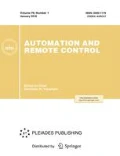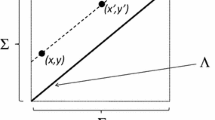Abstract
Representation of the binary relations and choice functions by the utility functions was considered. The results of utility maximization were presented for the classical case of no comparison threshold and with a threshold depending on one alternative. Models were constructed where the threshold depends on two compared alternatives and/or admissible set of alternatives. A model of choice describing H.A. Simon's concept of choice was proposed and considered. The class of binary relations of partial order and its subclasses were studied. Some new classes of binary relations such as weak biorders and simple and simplest semiorders were constructed, and their representations by the threshold utility function were determined.
Similar content being viewed by others
REFERENCES
Bentham, J., An Introduction to the Principles of Moral and Legislation, London: Athlone, 1970.
Pareto, V., Cours d'économie politique, Lausanne: Rouge, 1889.
Pareto, V., Manuel d'économie politique, Paris: V. Giard et E. Brière, 1909.
Larichev, O.I., Teoriya prinyatiya reshenii (Decision Making Theory), Moscow: Logos, 2000.
Poincaré, H., La valeur de la science, Paris: Flammarion, 1903.
Armstrong, W., The Determinateness of the Utility Function, Econ. J., 1939, vol. 49, pp. 453-467.
Armstrong, W., A Note on the Theory of Consumer's Behavior, Oxford Econ. Papers, 1950, vol. 2, pp. 119-122.
Simon, H., Models of Bounded Rationality. Collected Papers, Cambridge: MIT Press, 1982.
Sen, A., Rational Behavior, in The New Palgrave: A Dictionary of Economics, Eatwell, J., Milgate, M, and Newman, P., Eds., London: Macmillan, 1987, vol. 4, pp. 68-76.
Sen, A., Internal Consistency of Choice, Econometrica, 1993, vol. 61, no.3, pp. 495-521.
Sen, A., The Formulation of Rational Choice, Am. Econ. Rev., 1994, vol. 84, pp. 385-390.
Sen, A., Maximization and the Act of Choice, Econometrica, 1997, vol. 65, no.4, pp. 745-779.
Emel'yanov, S.V. and Nappel'baum, E.L., Methods of Studying Complex Systems: Logic of Rational Choice, Itogi Nauki Tekhn., Tekhn. Kibern., 1977, no. 8, pp. 101-187.
Fechner, G.T., Elemente der Psychophysik, Leipzig: Breitkopf und Hartel, 1860.
Fishburn, P., Nontransitive Preferences in Decision Theory, J. Risk Uncertainty, 1991, vol. 4, no.1, pp. 113-134.
Cantor, G., Beitrage zur Begrüngüng der transfiniten Mengenlehre, Math. Ann., 1895, vol. 46, pp. 486-512.
Fishburn, P.C., Utility Theory for Decision Making, New York: Wiley, 1970.
Kreps, D., Notes on the Theory of Choice, London: Vestview Press, 1988.
Bridges, D.S. and Mehta, G.B., Representation of Preference Orderings, Berlin: Springer, 1995.
Birkhoff, G.D., Lattice Theory, Providence: AMS, 1979. Translated under the title Teoriya reshetok, Moscow: Nauka, 1984.
Fishburn, P.C., Mathematics for Decision Theory, Paris: Mouton, 1972.
Schröder, E., Vorlesungen ûber die Algebra der Logik, vol. 3, Leipzig: Teubner, 1890-1895.
De Morgan, A., On the Symbols of Logic I, Trans. Cambridge Philosophical Soc., 1864, vol. 9, pp. 78-127.
Peirce, C.S., On the Algebra of Logic, Am. J. Math., 1880, vol. 3, pp. 15-57.
Peirce, C.S., On the Logic of Number, Am. J. Math., 1881, vol. 4, no.2, pp. 85-95.
Peirce, C.S., A Theory of Probable Inference. Note B: The Logic of Relatives, in Studies in Logic by Members of the John Hopkins University, Boston, 1883, pp. 187-203.
Peirce, C.S., The Logic of Relatives, The Monist., 1897, vol. 7, no. 2, pp. 85-95.
Hausdorff, F., Grundzüge der Mengelehre, Leipzig: W. de Gruyter, 1914. Translated under the title Teoriya mnozhestv, Moscow: ONTI, 1937.
Social Choice and Individual Values, Arrow, K., Ed., New Haven: Yale Univ. Press, 1963.
Suzumura, K., Rational Choice, Collective Decisions, and Social Welfare, Cambridge: Cambridge Univ. Press, 1983.
Mirkin, B.G., Problema gruppovogo vybora (Problem of Group Choice), Moscow: Nauka, 1974.
Aleskerov, F.T., Interval Choice, in Modelirovanie i optimizatsiya slozhnykh sistem upravleniya (Modeling and Optimization of Conmplex Control Systems), Moscow: Nauka, 1990.
Aizerman, M.A. and Aleskerov, F.T., Vybor variantov (osnovy teorii) (Choice of alternatives (Fundamentals of Theory)), Moscow: Nauka, 1990.
Aizerman, M. and Aleskerov, F., Theory of Choice, Amsterdam: Elsevier, 1995.
Wiener, N., A Contribution to the Theory of Relative Position, Proc. Cambridge Philosoph. Soc., 1914, vol. 17, no.4, pp. 441-449.
Wiener, N., Studies in Synthetic Logic, Proc. Cambridge Philosoph. Soc., 1915, vol. 18, no.1, pp. 14-28.
Wiener, N., A New Theory of Measurement: A Study in the Logic of the Mathematics, Proc. London Math. Soc., 1921, vol. 19, no.2, pp. 181-205.
Fishburn, P.C. and Monjardet, B., Norbert Wiener on the Theory of Measurement (1914, 1915, 1921), J. Math. Psych., 1992, vol. 35, no.2, pp. 865-85.
Luce, R.D., Semi-orders and a Theory of Utility Discrimination, Econometrica, 1956, vol. 24, no.2, pp. 178-191.
Jamison, D.T. and Lau, L.J., Semiorders and the Theory of Choice, Econometrica, 1973, vol. 41, no.5, pp. 901-912.
Jamison, D.T. and Lau, L.J., Semiorders and the Theory of Choice: A Correction, Econometrica, 1975, vol. 43, pp. 975-977.
Fishburn, P.C., Notes and Comment. Semiorders and Choice Functions, Econometrica, 1975, vol. 43, no.5-6, pp. 975-977.
Schwartz, T., Choice Functions, “Rationality” Conditions, and Variations of the Weak Axiom of Revealed Preference, J. Econ. Theory., 1976, vol. 13, no.3, pp. 414-427.
Riguet, J., Les relations de Ferrers, C. R. Acad. Sci., 1951, vol. 232, pp. 1729-1730.
Ducamp, A. and Falmagne, J.C., Composite Measurement, J. Math. Psych., 1969, vol. 6, no.3, pp. 359-390.
Bouchet, A., Etude combinatoire des ordonnés finis; applications, Thèse doctorat d'état, Grenoble, 1971.
Bouchet, A., Codages et dimensions de relations binaires, Ann. Disc. Math., 1984, vol. 23, pp. 387-396.
Doignon, J.P., Monjardet, B., Roubens, M., et al., Biorder Families, Valued Relations, and Preference Modelling, J. Math. Psych., 1986, vol. 30, no.6, pp. 435-480.
Agaev, R., Interval Choice under Constraints on Error Functions, Inf. Sci., 1994, vol. 80, no.1, 2, pp. 1-14.
Cogis, O., Ferrers Digraphs and Threshold Graphs, Discrete Math., 1982, vol. 38, no.1, pp. 33-46.
Cogis, O., On the Ferrers Dimension of a Digraph, Discrete Math., 1982, vol. 38, no.1, pp. 47-52.
Doble, C.W., Doignon, J.P., Falmagne, J.-C., et al., Almost Connected Orders, Order, 2001, vol. 18, no.4, pp. 295-311.
Doignon, J.P., Generalization of Interval Orders, in Trends in Math. Psych., Degreef, E. and van Buggenhaut, J., Eds., Amsterdam: Elsevier, 1984, pp. 209-217.
Monjardet, B., Probabilistic Consistency, Homogeneous Families of Relations And Linear-Relations, in Trends in Math. Psych., Degreef, E. and van Buggenhaut, J., Eds., Amsterdam: Elsevier, 1984, pp. 271-281.
Monjardet, B., Intervals, Intervals..., Order, 1988, vol. 5, no.3, pp. 211-219.
Pirlot, M. and Vincke, Ph., Semiorders: Properties, Representations, Applications, Dordrecht: Kluwer, 1997.
Roubens, M. and Vincke, Ph., Preference Modelling, Lect. Notes Econ. Math. Syst., 1985.
Bogart, K.P., Intervals, Graphs, and Orders, Graph Theory. Notes New York Acad. Sci., 1993, vol. 24, pp. 23-42.
Golumbic, M.C., Algorithmic Graph Theory and Perfect Graphs, New York: Academic, 1980.
Mühring, R.H., Algorithmic Aspects of Comparability Graphs and Interval Graphs, in Graphs and orders, Rival, I. and Reidel, D., Eds., Dordrecht: Reidel, 1984, pp. 41-101.
Roberts, F., Measurement Theory, Massachusetts: Addison-Wesley, 1979.
Roberts, F., Homogeneous Families of Semiorders and the Theory of Probabilistic Consistency, J. Math. Psych., 1979, vol. 8, no.3, pp. 248-263.
Aleskerov, F. and Vol'skiy, V., Choice of the Best Alternatives on Binary Relations and the Extremizational Choice, Proc. 10th World Cong. Automat. Control, Munich, 1987, vol. 5.
Agaev, R.P. and Aleskerov, F.T., General Interval Choice Mechanisms and the Functions Generatet by Them, Avtom. Telemekh., 1993, no. 4, pp. 662-671.
Agaev, R. and Aleskerov, F.T., Interval Choice-Classic and General Cases, Math. Soc. Sci., 1993, vol. 26, no.3, pp. 249-272.
Aleskerov, F. and Monjardet, B., Utility Maximization Choice and Preference, Berlin: Springer, 2002.
Nakamura, Y., Semimetric Thresholds for Finite Posets, Math. Soc. Sci., 2003.
Aleskerov, F. and Masatlioğlu, Y., Choice and Binary Relations Representable via Utility Function and Supermodular or Multiplicative Error Function, Boğaziçi University Working Paper, ISS EC-98-02, 1998.
Őzbay, E., Numerical Representation of Binary Relations with Multiplicative Error Function: A General Case, Boĝaziçi University Working Paper, ISS EC-00-05, June, Istanbul, Turkey, 2000.
Masatlioĝlu, Y., Binary Relations Representable via Utility Function and Multiplicative Error Function, Inf. Sci., 2002.
Abbas, M. and Vincke, Ph., Preference Structures and Threshold Models, J. Multicrit. Dec. Making, 1993, vol. 2, pp. 171-178.
Abbas, M. and Vincke, Ph., Tangent Circle Orders: Numerical Representations and Properties, Preprint of Université Libre de Bruxelles, Belgium, 1994.
Fodor, J. and Roubens, M., Parametrized Preference Structures and some Geometrical Interpretation, J. Multicrit. Dec. Anal., 1997, vol. 6, no.4, pp. 253-258.
Simon, H., Models of Bounded Rationality. Collected Papers, Cambridge: MIT Press, 1982.
Aleskerov, F., Binary Relations, Numerical Comparisons with Errors and Rationality Conditions for Choice, Social Sci. Working Paper 812, Pasadena, California, 1992.
Aleskerov, F. and Masatlioğlu, Y., Choice and Binary Relations Representable via Utility Function and Supermodular or Multiplicative Error Function, Boğaziçi University Working Paper, ISS EC-98-02, 1998.
Aleskerov, F., Simple and Simplest Semiorders, Boğaziçi University Working Paper, ISS EC-01-08, 2001.
Aleskerov, F., Binary Representation of Choice Rationalizable by a Utility Function and an Additive Non-Negative Error Function, Math. Soc. Sci., 2002, vol. 43, no.2, pp. 177-185.
Aleskerov, F.T., Simple and Simplest Semiorders in the Problem of Extremization Choice with Additive Error, Avtom. Telemekh., 2002, no. 2, pp. 137-145.
Roberts, F., On Nontransitive Indifference, J. Math. Psych., 1970, vol. 7, no.4, pp. 243-258.
Fishburn, P., Binary Choice Probabilities on the Varieties of Stochastic Transitivity, J. Math. Psych., 1973, vol. 10, no.6, pp. 327-352.
Monjardet, B., Probabilistic Consistency, Homogeneous Families of Relations and Linear-Relations, in Trends in Math. Psych, Degreef, E. and van Buggenhaut, J., Eds., Amsterdam: Elsevier, 1984, pp. 271-281.
Aleskerov, F., The Interval Type Pareto Rule in the Problems of Multicriterial Decision Making, Proc. Int. Seminar on the modern methods of decision making, Bulgaria, Sofia, 1983.
Aleskerov, F.T., Bauman, E.V., and Vol'skii, V.I., Methods of Processing Interval Expert Estimates, Avtom. Telemekh., 1984, no. 3, pp. 384-389.
Aleskerov, F., Multicriterial Interval Choice Models, Inf. Sci., 1994, vol. 80, no.1/2, pp. 25-41.
Author information
Authors and Affiliations
Rights and permissions
About this article
Cite this article
Aleskerov, F.T. Threshold Utility, Choice, and Binary Relations. Automation and Remote Control 64, 350–367 (2003). https://doi.org/10.1023/A:1023253306302
Issue Date:
DOI: https://doi.org/10.1023/A:1023253306302




